Punjab State Board PSEB 7th Class Science Book Solutions Chapter 14 Electric Current and Its Effects Textbook Exercise Questions and Answers.
PSEB Solutions for Class 7 Science Chapter 14 Electric Current and Its Effects
Science Guide for Class 7 PSEB Electric Current and Its Effects Intext Questions and Answers
Think and Answer (Textbook Page No. 175)
Question 1.
How many terminals are there in an electric cell? Name them.
Answer:
There are two terminals in an electric cell : (1) Positive and (2) Negative terminal.
Question 2.
What is the role of the switch in the electrical circuit?
Answer:
In electrical circuit the switch completes and breaks the circuit i.e. the switch is there to make the current flow in the complete electrical circuit and to stop the flow of current by breaking the circuit when required.
![]()
Think and Answer (Textbook Page No. 176)
Question 1.
When switch is in ‘ON’ position then bulb …………………. and feels ……………… .
Answer:
Glows, hot.
Think and Answer (Textbook Page No. 176)
Question 1.
When switch is OFF the wire feels hot. (True/False)
Answer:
False.
Question 2.
When switch is ON the wire feels cold. (True/False)
Answer:
False.
Question 3.
If you take any other wire, will you feel the same effect.
Answer:
Because the current heats up the wire because of thermal effect of electricity. It will feel the same when you take any other wire.
Think and Answer (Textbook Page No. 178)
Question 1.
Why a magnetic needle point in NS direction when there is no magnetic substance near it ?
Answer:
A magnetic needle is a unique magnet with one end as the North Pole and the other as the South Pole. Our earth behaves like a giant magnet with its magnetic north pole coinciding with its geographical south direction and its magnetic south pole coinciding with geographical north direction. The North Pole of a magnetic needle that is a magnet is free to rotate horizontally on its axis is attracted towards the earth’s magnetic South Pole and the south pole of the magnetic needle towards the earth’s magnetic north pole. So even though no magnetic substance nearby, the magnetic needle still points north-south direction.
Question 2.
Why magnetic needle gets deflected when a bar magnet is brought near it ?
Answer:
Similar poles of magnets repel each other and opposite poles attract each other. So when the rod magnet is brought close to the magnetic needle (which is a tight magnet), the magnetic needle, which is free to rotate, disintegrates.
Question 3.
Why a magnetic needle gets deflected when current is switched on ?
Answer:
When the electric current is turned on, the magnetic field indicates that a magnet is located near it as current carrying wire behaves like a magnet.
PSEB 7th Class Science Guide Electric Current and Its Effects Textbook Questions and Answers
1. Fill in the Blanks:
(i) Shorter line in the symbol for cell represents …………………. .
Answer:
Negative terminal
(ii) Combination of two or more cells is called …………………. .
Answer:
Battery
![]()
(iii) When key is in ………………….. position current flows through the circuit.
Answer:
On
(iv) In a battery positive terminal of one cell is connected to ………………….. terminal of next cell.
Answer:
Positive
(v) Electric heater works on the ………………… effect of current.
Answer:
Heating
2. State True or False:
(i) To make a battery of two cells, positive terminal of one cell is connected to negative terminal of another.
Answer:
True
(ii) Electric iron works on the basis of heating effect of current.
Answer:
True
(iii) Magnetic crane is based on magnetic effect of current.
Answer:
True
(iv) When current flows in the circuit then circuit is called open circuit.
Answer:
False
(v) An electric bell works on the principle of electromagnet.
Answer:
True
![]()
3. Match the Column ‘I’ with Column ‘II’:
| Column ‘I’ | Column ‘II’ |
| (i) Electrical cell | (a) Electric component |
| (ii) Electrical heater | (b) Heating effect of current |
| (iii) Electric fuse | (c) Electromagnet |
| (iv) Magnetic crane | (d) Safety device |
Answer:
| Column ‘I’ | Column ‘II’ |
| (i) Electrical cell | (d) Safety device |
| (ii) Electrical heater | (b) Heating effect of current |
| (iii) Electric fuse | (a) Electric component |
| (iv) Magnetic crane | (c) Electromagnet |
4. Choose the Correct Answer:
Question (i)
Which appliance is not based on heating effect of current?
(a) Electric toaster
(b) Loudspeaker
(c) Heater
(d) Electric iron.
Answer:
(b) Loudspeaker.
Question (ii)
Which of these devices are not based on magnetic effect of current ?
(a) Room heater
(b) Magnetic crane
(c) Electric bell
(d) Loudspeaker.
Answer:
(a) Room heater
Question (iii)
The amount of heat produced in wire depends on:
(a) Nature of material
(b) Length
(c) Thickness
(d) All of these.
Answer:
(d) All of these.
Question (iv)
The wire used in the bulb is called:
(a) Element
(b) Spring
(c) Filament
(d) Component.
Answer:
(c) Filament.
Question (v)
An electric bell consists of:
(a) Gong
(b) Hammer
(c) Electromagnet
(d) All of these.
Answer:
(d) All of these.
5. Very Short Answer Type Questions:
Question (i)
What is an electromagnet ? How does it work ?
Answer:
Electromagnet. A piece of iron temporarily becomes a magnet when placed inside a current carrying coil of enamel-coated copper wire.
While when the electric current is switched off. it behaves like iron again i.e. it loses its magnetic properties.
![]()
Question (ii)
What is a magnetic crane ? How does it work ?
Answer:
Magnetic Crane. It is a normal crane with a powerful electromagnet attached to one end. When a current is passed, it becomes a powerful magnet which attracts and separates the iron from the garbage and when the electric current is switched off, it loses its magnetic properties.
Question (iii)
Draw an electric circuit with one battery, one bulb and one switch in open position.
Answer:
Diagram of an electrical circuit with a battery, a bulb, and an open switch.
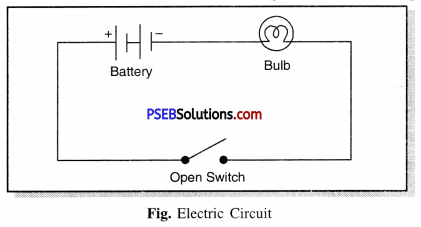
6. Short Answer Type Questions:
Question (i)
Define the following:
(1) An Electric cell,
(2) A Battery,
(3) Electric circuit,
(4) Open circuit,
(5) Closed circuit.
Answer:
(1) An Electric Cell. It is a source of energy that converts chemical energy stored in it
into electrical energy. It has two electrodes – (1) positive electrode and (2) negative electrode.
(2) A Battery. This is a combination of two or more cells that are combined in a series order to get current. It is used in flashlights, toys and cars etc. where more current is required.
(3) Electric Circuit. The path that starts from one terminal of the cell through the bulb, reaches the other terminal and in which electric current can flow.
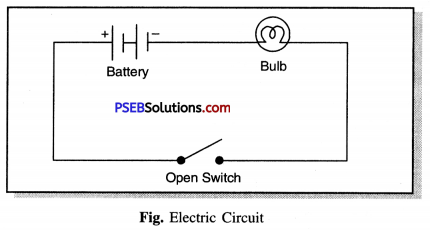
(4) Open Circuit. If there is no current flowing through the electrical circuit, then such a circuit is called open circuit.
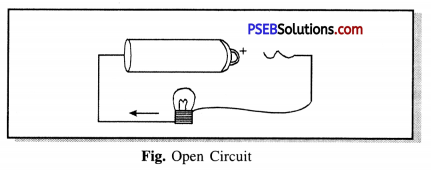
5. Closed Circuit. An electrical circuit through which an electric current flows is called a closed circuit.
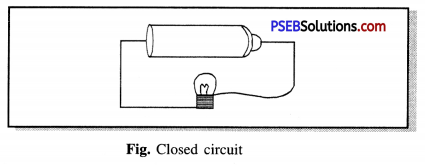
7. Long Answer Type Questions:
Question (i)
Explain the principle, construction and working of an electric bell using suitable diagram.
Answer:
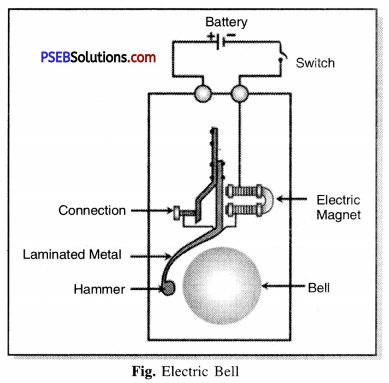
Electric bell. It is a mechanical device that works on the principle of an electro magnet. This produces sound on repeated passing of electric current
Principle. A soft iron piece placed inside a copper coil carrying current behaves like a magnet.
Construction. It consists of the following main components:
1. Electromagnet. It consists of a laminated metal wire which is wrapped around an iron bar. This bar becomes an electriomagnet when an electric current passes through wire.
2. Hammer. It is an iron blade/ leaf with a small metal ball at one end called a hammer. It is placed near the electromagnet. There is a contact screw near the iron leaf.
3. Gong. It is made of a cup shaped metal. When the hammer is attracted it hits the bell and a sound is heard.
Working.
When we turn on the switch, Battery the contact screw comes in contact with the iron leaf due to which an electric current flows in the electric coil and it becomes an electromagnet. This electromagnet attracts the iron leaf, causing the hammer to strike the bell and make a sound but during this operation the contact of the hammer is broken by the screw which breaks the electrical circuit. Due to this the coil now has the same properties as an electromagnet and cannot attract an iron leaf. Now the iron leaf returns to its original position and touches the contact screw again. It again generates an electromagnet and the hammer strikes the bell again. This action is repeated quickly and the bell rings again and again.
Question (ii)
What is an electric fuse ? How does it work ? Why is it an essential component in an electric supply ?
Answer:
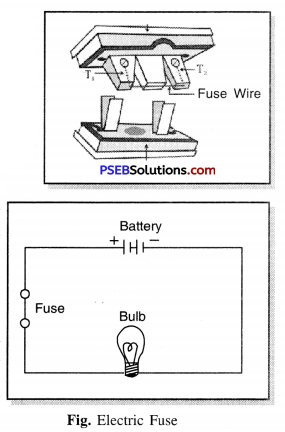
Electric Fuse.
It is a safety device which prevents damages to electric circuits and prevents electric fires. Sometimes, the two wires of electricity at home and factories come in contact with each other and cause short circuit then the amount of electric current of circuit increases as a result of decrease in resistance and the electric appliances. The circuit catch fire due to production of heat. To Prevent this type of danger, fuse wires are connected to circuit wires.
Working.
In general, the fuse wire is a thin, small wire which is an alloy of copper, tin and lead. It has a very low melting point as compared to copper. This wire is connected between the two terminals of a Porcelain holder. For the circuit which is to keep safe, the two joining wires are connected in series.
The fuse wire has a fixed capacity according to its thickness. The fuse wire, when more current passes through it, melts after getting heated. The circuit breaks with the melting of the wire and the flow of electric current is obstructed. As a result the fault in any instrument or circuit is found out immediately. After removing that fault, a new fuse wire is put in fuse holder and the flow of electric current is started again.
![]()
PSEB Solutions for Class 7 Science Electric Current and Its Effects Important Questions and Answers
1. Fill in the Blanks:
(i) An electrical circuit with standard symbols is called ………………….. .
Answer:
Circuit diagram
(ii) When we bring the switch to ‘ON’ position, the hot plate, electric toaster, and electric press get heated up due to ……………….. _ of electricity.
Answer:
Heating effect
(iii) Fuse is a ………………. device.
Answer:
Safety
(iv) Laminated copper wire wound around a wooden cylinder is called ………………. .
Answer:
Coil
(v) Magnet has two poles, one is ……………… pole and other is ……………… pole.
Answer:
North, South
(vi) Long line in the symbol of electric cell represents ……………… terminal.
Answer:
Positive
2. Match the Column ‘I’ with Column ‘II’:
| Column ‘I’ | Column ‘II’ |
| (i) Circuit diagram | (a) Making an electromagnet due to current |
| (ii) Electric bell | (b) Electric fuse |
| (iii) Safety technique | (c) Fuse wire |
| (iv) Melts quickly. | (d) An electrical circuit with standard symbols |
Answer:
| Column ‘I’ | Column ‘II’ |
| (i) Circuit diagram | (d) An electrical circuit with standard symbols |
| (ii) Electric bell | (a) Making an electromagnet due to current |
| (iii) Safety technique | (b) Electric fuse |
| (iv) Melts quickly. | (c) Fuse wire |
![]()
3. Choose the Correct Answer:
Question (i)
The device that breaks the electrical circuit:
(a) Electric Cell
(b) Electric Bulb
(c) Switch
(d) None of the above
Answer:
(c) Switch.
Question (ii)
There are ……………… terminals of electric bulbs:
(a) Two
(b) Four
(c) Three
(d) One
Answer:
(a) Two.
Question (iii)
Used to make connecting wires:
(a) Rubber
(c) Plastic
(b) Aluminium
(d) None of the above.
Answer:
(b) Aluminium.
Question (iv)
An electric current passed through an electric bulb but the bulb did not light up because:
(a) The filament is broken
(b) The filament is resistant to electricity
(c) The filament is the conductor of electricity
(d) None of these.
Answer:
The filament is broken.
Question (v)
The direction of electric current flowing from the cell in the electrical circuit is:
(a) From the positive terminal to the negative terminal
(b) From the negative terminal to the negative terminal
(c) Negative to positive terminal for the first half and positive to negative terminal for the next half.
(d) None of these.
Answer:
(a) From the positive terminal to negative terminal.
Question (vi)
Melting point of fuse wire should be:
(a) low
(b) high
(c) neither high nor low
(d) None of the above.
Answer:
(a) low.
Question (vii)
The filament of the bulb is made of:
(a) Iron
(b) Copper
(c) Tungsten
(d) Tin.
Answer:
(c) Tungsten.
![]()
Question (viii)
Fuse wire is made of:
(a) Tin
(b) Aluminium
(c) Lead
(d) Copper.
Answer:
(a) Tin.
Question (ix)
What is the reason for deflection of compass when the switch in ‘ON’ position ?

(a) Due to heat
(b) Formation of Magnetic Field
(c) Due to Chemical Reaction
(d) None of the above.
Answer:
(b) Formation of Magnetic Field.
4. State True or False:
(i) The electromagnet attracts the safety pin when the flow of electric current is stopped.
Answer:
False
(ii) The strength of electromagnet doesn’t depend up on the number of turns of the coil wrapped around it.
Answer:
False
(iii) The direction of flow of electric current in an electrical circuit is from positive terminal to negative terminal.
Answer:
True
(iv) To make a battery, two or more cells have to be joined in series by connecting the negative terminal of the first cell to the positive terminal of the second cell and the negative terminal of the second cell to the positive of third cell.
Answer:
True
(v) The same poles of a magnet attract and opposite poles repel each other.
Answer:
False
(vi) To make battery of two cells the negative terminal to one cell is connected to negative terminal of another cell.
Answer:
False
![]()
Very Short Answer Type Questions
Question 1.
From where does the torch get electricity ?
Answer:
Electric cell.
Question 2.
How many terminals an electric cell has ?
Answer:
Two terminals, one + ve and other – ve.
Question 3.
What is the function of an electric switch ?
Answer:
To make or break the electric circuit.
Question 4.
Which bulb does not glow even if it is connected to the cell ?
Answer:
Fused bulb.
Question 5.
What is the main reason of fused bulb ?
Answer:
A broken filament.
Question 6.
What is an electromagnet ?
Answer:
Electromagnet. A piece of soft iron which acquires magnetic properties on passing electric current, through a solenoid wound around iron piece, is called electromagnet.
Question 7.
On which factor does magnetism produced depends ?
Answer:
The magnetism produced depends on:
- Amount of current flowing through the coil.
- Number of turns wound on the soft iron piece.
![]()
Short Answer Type Questions
Question 1.
Show how will you connect a bulb and a torch cell to make it glow ?
Answer:
Diagram showing connection of a bulb and torch cell.
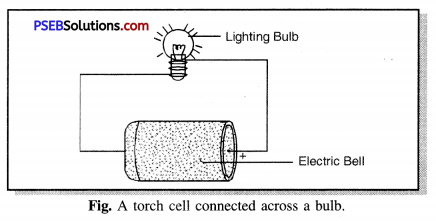
Question 2.
How can you test the conductivity of a given material ?
Answer:
To test conductivity of a given material, we connect the two ends of that material to positive (+) and negative (-) terminal of a cell through a bulb. If after connecting the material the bulb lights up, the material is a conductor and if bulb does not light up, the material is an insulator.
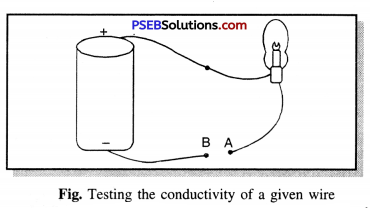
Question 3.
Draw in your note book the symbols to represent the following components of an electrical circuit, connecting wires, switch in the ‘OFF’ position, Bulb, Cell, Switch in the ‘ON’ position and Battery.
Answer:
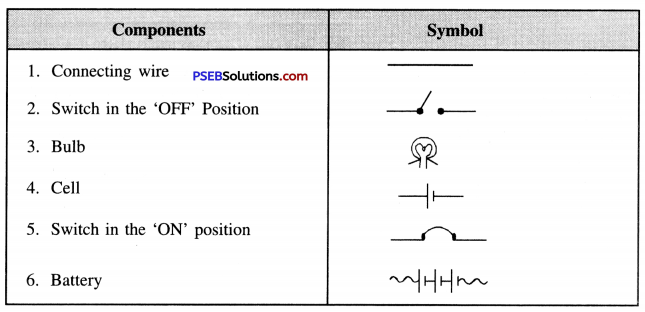
Question 4.
Name any two effects of electric current.
Answer:
Effects of electric current:
- Heating effect
- Magnetic effect.
Question 5.
When the current is switched on through a wire, a compass needle kept nearby gets deflected from its north-south position. Explain.
Answer:
On passing current, the wire behaves like a bar magnet and affects the compass needle kept nearby so that it gets deflected from its N – S position.
Question 6.
An electrician is carrying out some repairs in your house. He wants to replace a fuse by a piece of wire. Would you agree ? Give reasons for your suggestion.
Answer:
Fuse wire cannot be replaced by any wire because fuse wire must have low melting point. If any other ordinary wire is used then it may result in fire and destroy other electrical appliances.
Question 7.
What are the basic requirements for an electric circuit.
Answer:
The basic requirements of an electric circuit are:
- Source of current (cell, battery etc.).
- Electric device for supplying electric current.
- Connectivity wires (for providing a path to the flow of current).
- Switch (for making and breaking the circuit).
![]()
Question 8.
Do you think an electromagnet can be used for separating plastic bags from a garbage heap ? Explain.
Answer:
No, plastic bags cannot be separated from garbage heap using an electromagnet because electromagnet can attract only magnetic materials towards it. If these plastic bags have metal / iron handles, only then they can be lifted by using an electromagnet.
Question 9.
Will the compass needle show deflection, when the switch in circuit shown in fig. given below is closed ?
Answer:
The compass needle will show deflection because circuit is complete. It is because when switch is closed, passage of current will produce a magnetic field around the in which causes deflection of compass needle.
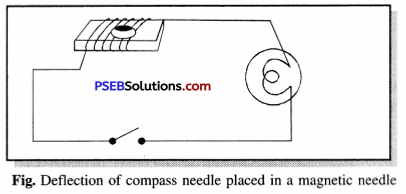
Question 10.
Zubeda made an electric circuit using a cell holder shown in fig. a switch and a bulb. When she put the switch in the ‘ON’ position the bulb did not glow. Help Zubeda in identifying the possible defect in the circuit.
Answer:
She may have connected -ve terminal to -ve terminal or positive terminal to the positive terminal in a cell holder.
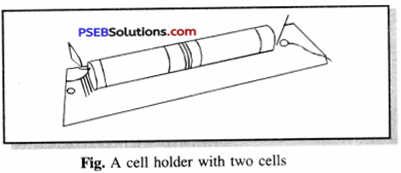
Question 11.
Fig. given below shows four cells fixed on a board. Draw lines to indicate how will you connect their terminals with wires to make a battery of four cells.
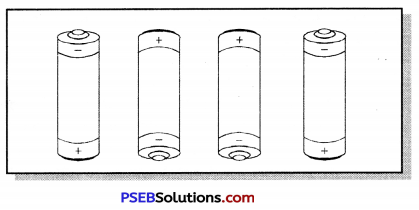
Answer:
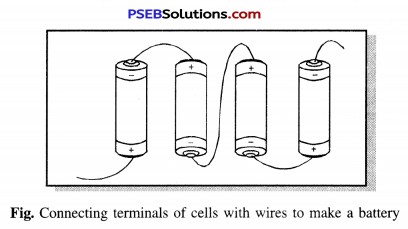
Question 12.
The bulb in the circuit shown in fig. given below does not glow. Can you identify the problem ? Make necessary changes in the circuit to make the bulb glow.
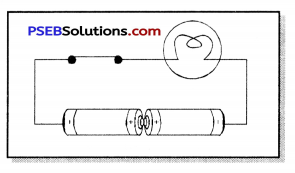
Answer:
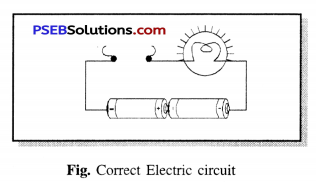
Long Answer Type Question
Question 1.
What is an electromagnet ? How can it be prepared ? What are the factors that affect its power ? Also write down the uses of electromagnets.
Answer:
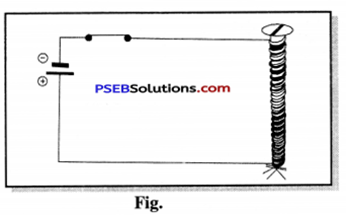
Electromagnet.
A piece of iron wrapped by enamel-coated copper wire forming a coil. This piece of iron temporarily becomes a magnet when an electric current passes through coil. Such a magnet is called Electromagnet.
Making an electromagnet.
Take approximately 6-10 cm long iron nail and a 50 cm plastic coated wire. Wrap the wire around the iron nail in the form of a coil. Connect the independent ends of the wire to the terminals of the power cell through the switch as shown in the figure.
Turn the switch on and now bring some pins closer to the end of the nail. You will notice that the pins are pulled towards the nail, because the coil behaves like a magnet when an electric current passes through it. An iron nail lies in this magnetic field also becomes a magnet. When the flow of electric current ceases the magnetic effect of the coil and then of the nail disappears. This coil-nail setup becomes an electromagnet.
Factors Affecting the Power of Electromagnetism:
- Strength of electric current.
- The number of turns of wire wrapped around the iron nail.
Uses of electromagnets:
- To lift heavy iron objects and to separate the magnetic material from the heap of scrap: a strong electromagnet is placed at one end of the crane.
- Electromagnets are also used in many toys.
- Doctors use an electromagnet to remove a small piece of magnetic material that may have entered the eye of a worker accidentally.
- It is also used in many devices: such as an electric bells, telegraphs, telephones, speakers, etc.
